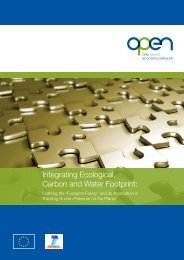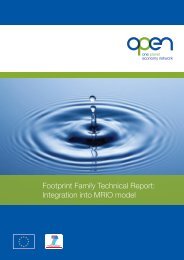OPEN: EU Scenario Storylines Report: - One Planet Economy Network
OPEN: EU Scenario Storylines Report: - One Planet Economy Network
OPEN: EU Scenario Storylines Report: - One Planet Economy Network
Create successful ePaper yourself
Turn your PDF publications into a flip-book with our unique Google optimized e-Paper software.
Energy and transport<br />
� Power station efficiency standards. Extremely tough efficiency improvement<br />
standards were enforced on existing coal and gas-fired power stations from 2015<br />
onwards, partly because of fear that new technologies would not fall in cost as<br />
rapidly.<br />
� Fossil fuel taxes. Most substantial increase in fuel taxes ―at the pump‖ to drive<br />
vehicle efficiency improvements, stimulate sustainable biofuels uptake and reduce<br />
consumption since the breakthroughs in electric mobility and other technologies<br />
was not as successful in this <strong>Scenario</strong>. These types of measures were applied to<br />
the entire transport sector (e.g. the aviation sector was forced to use biofuels,<br />
significantly increasing its costs). Individual transport (via road, air etc) becomes<br />
unaffordable for many people.<br />
� Carbon pricing. Despite the efficiency standards imposed on power stations,<br />
carbon prices spiked rapidly (e.g. reaching towards 100 <strong>EU</strong>R /tonne by 2020) due<br />
to the lower pace of technological innovation on key technologies including largescale<br />
renewable energy (e.g. CSP) plant and advanced fossil fuel plant<br />
incorporating CCS. Expensive nuclear power has the greatest role in this <strong>Scenario</strong>,<br />
adding to social tension in many countries. The high energy prices cause an<br />
affordability crisis for many consumers. From 2020 to 2030 a softening of<br />
emissions credit import restrictions was implemented under the <strong>EU</strong> ETS to try to<br />
push down carbon prices to soften impact on European industry and households.<br />
The worsening trade and geopolitical relationship with the rest of the world (see<br />
below) made this approach rather ineffective. Energy and emissions-intensive<br />
goods and services remained expensive throughout the period.<br />
� Energy retrofit subsidies. Massive government subsidisation of energy efficient<br />
building retrofits and strong enforcement of building retrofitting standards were<br />
introduced from 2030 onwards after a series of devastating energy shocks to<br />
address the lack of technological solutions on the supply side (and hence drive<br />
emissions reductions via lowering demand).<br />
Agriculture and land use<br />
� Major CAP Reform. 12 Direct payments have become more equitably distributed<br />
among Member States, but significantly lower overall and only where the<br />
crop/animal product meets a carbon intensity performance standard. There was<br />
some elimination of market intervention measures and trade barriers, but not to<br />
the same extent as <strong>Scenario</strong> 2. Additional environmental service/benefit payment<br />
was phased in by 2018.<br />
� Organic farming measures to achieve 50% organic production in the <strong>EU</strong><br />
and extra-<strong>EU</strong> controlled lands. By regulation the share of organic farming<br />
increased significantly, but less aggressively than in all other scenarios, by 2.2%<br />
every year (from 2007 baseline of 4.1% in the <strong>EU</strong> 27) to 28.6% in 2020 and up to<br />
50% in 2050. To meet the 50%, the <strong>EU</strong> purchased land located outside of the <strong>EU</strong><br />
27, mainly in developing countries, for the purpose of organic farming and other<br />
food production.<br />
12 In this scenario, the architecture of the CAP is conceptually in-line with Option 2 of the CAP Towards 2020 EC<br />
Com.<br />
Page 37 of 57





